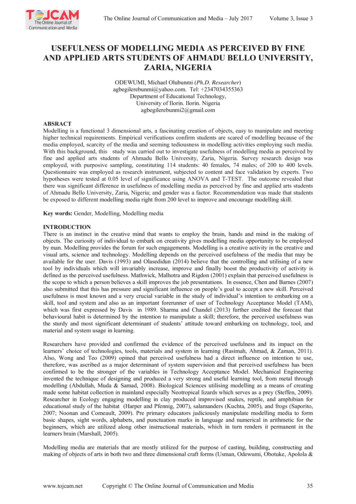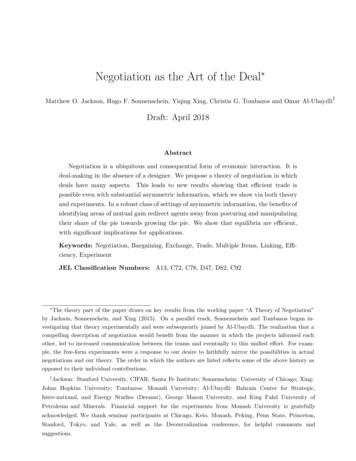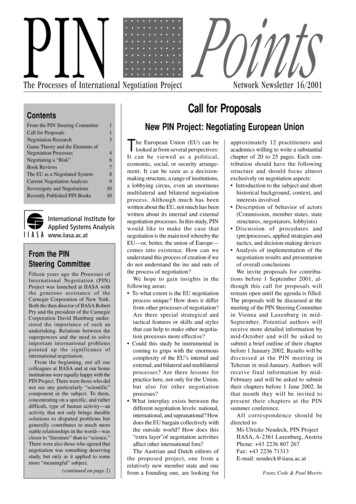
Transcription
Modelling ciphersuite and version negotiationin the TLS protocol Benjamin Dowling1 and Douglas Stebila1,21School of Electrical Engineering and Computer Science2School of Mathematical SciencesQueensland University of Technology, Brisbane, Australia{b1.dowling,stebila}@qut.edu.auApril 17, 2015AbstractReal-world cryptographic protocols such as the widely used Transport Layer Security(TLS) protocol support many different combinations of cryptographic algorithms (calledciphersuites) and simultaneously support different versions. Recent advances in provablesecurity have shown that most modern TLS ciphersuites are secure authenticated andconfidential channel establishment (ACCE) protocols, but these analyses generally focus onsingle ciphersuites in isolation. In this paper we extend the ACCE model to cover protocolswith many different sub-protocols, capturing both multiple ciphersuites and multiple versions,and define a security notion for secure negotiation of the optimal sub-protocol. We give ageneric theorem that shows how secure negotiation follows, with some additional conditions,from the authentication property of secure ACCE protocols. Using this framework, weanalyse the security of ciphersuite and three variants of version negotiation in TLS, includinga recently proposed mechanism for detecting fallback attacks.Keywords: Transport Layer Security (TLS); ciphersuite negotiation; version negotiation;downgrade attacks; cryptographic protocols This research has been supported by Australian Research Council (ARC) Discovery Project grant DP130104304.1
Contents1 Introduction32 The TLS Protocol2.1 Ciphersuite negotiation in TLS . . . . . . . . . . . . . . . . . . . . . . . . . . . .2.2 Version negotiation in TLS . . . . . . . . . . . . . . . . . . . . . . . . . . . . . .5563 Security definitions3.1 Authenticated and confidential channel establishment (ACCE) protocols . . . . .3.2 Negotiable ACCE protocols . . . . . . . . . . . . . . . . . . . . . . . . . . . . . .6694 Negotiation-authentication theorem115 Analysis of TLS ciphersuite negotiation126 Analysis6.1 TLS6.2 TLS6.3 TLS12121213of TLS version negotiationno-fallback version negotiation is secure . . . . . . . . . . . . . . . . . . . .fallback version negotiation is not secure . . . . . . . . . . . . . . . . . . . .fallback version negotiation with SCSV is secure . . . . . . . . . . . . . . .7 Discussion14A Proofs17A.1 Proof of Theorem 1 (negotiation-authentication) . . . . . . . . . . . . . . . . . . 17A.2 Proof of Corollary 1 (TLS ciphersuite negotiation) . . . . . . . . . . . . . . . . . 17A.3 Proof of Corollary 2 (TLS no-fallback version negotiation) . . . . . . . . . . . . . 18B Need for contiguous support of TLS version for fallback with SCSV218
1IntroductionThe security of much communication on the Internet depends on the Transport Layer Security(TLS) protocol [DA99, DR06, DR08], previously known as the Secure Sockets Layer (SSL)protocol [FKK11]. TLS allows two parties to authenticate each other using public keys andsubsequently establish a secure channel which provides confidentiality and integrity of messages.The general structure of all versions of SSL and TLS is that a handshake protocol is run,in which a set of cryptographic preferences are first negotiated, then an authenticated keyexchange protocol is used to perform mututal or server-to-client authentication and establish ashared session key; and then the record layer is active, in which the shared session key is usedwith authenticated encryption for secure communication. TLS supports many combinations ofcryptographic parameters, called ciphersuites: as of this writing, more than 300 ciphersuiteshave been standardized, with various combinations of digital signature algorithms, key exchangemethods, hash functions, ciphers and modes, and authentication codes.Given the paramount importance of TLS, formal understanding of its security is an importantgoal of cryptography. Wagner and Schneier [WS96] were among the first to study SSL, andin particular compared SSLv3 [FKK11] to SSLv2 [Hic95]. A key difference was that SSLv3provided authentication of the full handshake, whereas SSLv2 omitted the ciphersuite negotiationmessages, leaving SSLv2 vulnerable to ciphersuite rollback attacks: an active attack could forceclients and servers to negotiate weaker ciphersuites than the best they mutually support.Provable security of TLS. A significant body of work is devoted to studying the provablesecurity of TLS: the majority of it focuses on individual ciphersuites. Early work on theprovable security of TLS analyzed truncated forms of the TLS handshake [JK02, MSW08] anda simplified record layer [Kra01]. More recently, unmodified versions of the TLS constructionshave been studied by introducing suitable security definitions. Paterson et al. [PRS11] showedthat certain modes of authenticated encryption in the TLS record layer satisfy a propertyknown as secure length-hiding authenticated encryption. In 2012, Jager et al. [JKSS12] showedthat, under suitable assumptions on the underlying cryptographic primitives, the signed-Diffie–Hellman TLS ciphersuite is a secure authenticated and confidential channel establishment (ACCE)protocol, yielding the first full proof of security of an unmodified TLS ciphersuite. Subsequentefforts [KPW13, KSS13, LSY 14] have shown that most other TLS ciphersuites (using static orephemeral Diffie–Hellman, RSA key transport, or pre-shared keys) are also secure. Other recentapproaches to analyzing TLS include an alternative composability notion [BFS 13] and formalverification of an implementation [BFK 13].Previous security results on TLS all focus on analyzing a single ciphersuite in isolation.Among other things, TLS allows for versions and ciphersuites to be negotiated within the protocol,sessions to be resumed, renegotiation within a session. Moreover, in practice servers often use thesame long-term key in many different ciphersuites, and browsers re-attempt failed handshakeswith lower versions. This variety of complex functionality leaves a gap between single-ciphersuiteresults and real-world security. Some work has tried to bridge that gap: Giesen et al. [GKS13]extended the ACCE model to analyze the renegotiation security of TLS in light of the attack ofRay and Dispensa [RD09]; Mavrogiannopoulos et al. [MVVP12] demonstrated a cross-ciphersuiteattack first suggested by Wagner and Schneier [WS96] when the same long-term signing key isused in two different key exchange methods; Bergsma et al. [BDK 14] developed an ACCE-basedmodel for multi-ciphersuite security and showed that the Secure Shell (SSH) protocol is multiciphersuite security, though the Mavrogiannopolous et al. attack rules out a general proof thatTLS is multi-ciphersuite secure; and Bhargavan et al. [BFK 14] showed that some combinationsof ciphersuites do support key agility (a concept related to multi-ciphersuite security).3
Ciphersuite and version negotiation. This work aims to give a formal treatment of thenegotiation of ciphersuites and versions in real-world protocols like TLS. For ciphersuite negotiation in TLS, the client sends in its first handshake message a list of its supported ciphersuites inorder of preference, and the server responds with one of those that it also supports. With regardsto version negotiation, most browsers and servers support multiple versions of SSL and TLS,with the majority supporting and accepting SSLv3 and TLSv1.0 (with more modern softwarealso supporting TLSv1.1 and TLSv1.2). The differences between versions can significantlyaffect security: TLSv1.1 and TLSv1.2 are less vulnerable to certain weaknesses in record layerencryption in some ciphersuites; SSLv3 does not support extensions in the ClientHello andServerHello negotiation messages; and some extensions such as the Renegotiation InformationExtension [RRDO10] are essential to prevent certain types of attacks; and some ciphersuiteswith newer, more efficient and secure algorithms are only supported in TLSv1.2.The TLS protocol standards support a limited version negotiation mechanism at present:the client sends the highest version it supports, and the server responds with the highest versionit supports that is less than or equal to the client’s version, and that is the version the partiescontinue to use. However, some server implementations do not correctly respond to ClientHellomessages containing higher versions, and instead of returning their highest supported versionin the ServerHello message will instead fail and return an error. Thus, in practice a morecomplex version negotiation mechanism is often employed by web browsers, sometimes called the“downgrade dance”. The client’s browser will try to negotiate the highest version it supports(say, TLSv1.2); if the handshake fails, then the browser will retry with each lower enabledversion (TLSv1.1, TLSv1.0, SSLv3) until it succeeds. This improved compatibility with incorrectserver implementation comes at the cost of decreased efficiency and more importantly decreasedsecurity: the client and server have no way of detecting whether the negotiated version is actuallythe highest version they both support or a lower version due to an attacker maliciously injectingfailure messages. In light of this potential downgrade attack, a very recent Internet-Draft byMöller and Langley has proposed a new backwards-compatible mechanism for detecting suchattacks [ML15], but as of this writing has yet to be standardized or deployed. The SCSVextension is proposed to work as follows: If the client is falling back to an earlier version due toa handshake failure, the client includes the SCSV value indicating that it has fallen back; if theserver observes the fallback SCSV but supports a higher version than the client requests, theserver returns an error indicating that inappropriate fallback has been detected.Contributions. We investigate the security of version and ciphersuite negotiation in TLS.We do so by introducing an extension to the ACCE security model that generically capturesnegotiation of “sub-protocols”. In particular, using ideas from the multi-ciphersuite ACCEsecurity experiment of Bergsma et al. [BDK 14], we extend the ACCE security experiment toinclude “sub-protocols”: a single protocol (such as TLS) consists of a negotiation protocol NP# and several sub-protocols SP (such as different ciphersuites or different versions), and in eachsession the parties use the negotiation protocol to identify which sub-protocol they will use forthat session. We define secure negotiation for a negotiable protocol, and use this to derivea negotiation-authentication theorem which allows us to relate the security of sub-protocolnegotiation to ACCE authentication under certain conditions. Intuitively, if each sub-protocolindividually is a secure ACCE protocol with an independent long-term key, and if the transcriptof all of the messages in the negotiation protocol is authenticated by the sub-protocol, thenthe authentication detects any attempt by an attacker to carry out a downgrade attack. It isimportant to note that the aforementioned cross-ciphersuite attack breaks ACCE authenticationsecurity under long-term key reuse setting; thus, in order to obtain results on multi-ciphersuiteTLS, our framework assume long-term keys are independent for each sub-protocol. Existinganalyses of TLS show ([JKSS12, KPW13, KSS13, LSY 14]) that authentication security of TLSholds under independent long-term key assumptions.4
Having established the secure negotiation framework and tools we proceed to study versionand ciphersuite negotiation in TLS in several forms:1. Ciphersuite negotiation within a single version: For a fixed version of TLS, by applicationof the negotiation-authentication theorem we show that TLS provides secure ciphersuitenegotiation.2. Version negotiation, no fallback: For clients and servers that support multiple versionsof TLS but do not attempt to fallback to earlier versions upon handshake failure, weshow that TLS also provides secure version negotiation via the negotiation-authenticationtheorem.3. Version negotiation, with fallback: For clients and servers that support multiple versions ofTLS and where the client will fallback to earlier versions if the handshake fails, we see thatsecure negotiation is not provided demonstrating that our secure negotiation definitiondoes detect this undesired behaviour.4. Version negotiation, with fallback using signalling ciphersuite value (SCSV): A recentInternet-Draft [ML15] proposes the use of a special flag in the ClientHello message. Weshow that this SCSV does provide TLS with a secure version negotiation mechanism evenwhen fallbacks are used.2The TLS ProtocolIn this section, we give the details for ciphersuite negotiation and three variants of versionnegotiation in the TLS protocol. The following is a description of the two messages most relevantto TLS ciphersuite and version negotiation: the ClientHello and ServerHello messages;descriptions of the subsequent messages can be found in the TLS protocol specification [DR08]. ClientHello: Sent by the client to begin the TLS handshake. Consists of: the highestversion that the client supports v; a random nonce rc ; the optional identifier of previoussession that the client wishes to resume; a list of client ciphersuite preferences # c ; and anoptional list of extensions extensions describing additional options or functionality. ServerHello: Sent by the server in response to ClientHello. Consists of: the negotiatedchoice of version v; a random nonce rs ; a session identifier; the negotiated choice ofciphersuite c ; and an optional list of extensions.2.1Ciphersuite negotiation in TLSClient session πClientHello.CipherSuite π. # cπ.sid π.sidkClientHelloClientHelloServer session π̂# c 0 ClientHello.CipherSuitec ci where i min{j : π̂.cj # c 0}ServerHello.cipher suite c , π̂.c c π̂.sid π̂.sidkClientHellokServerHelloServerHelloπ.c ServerHello.cipher suiteπ.sid π.sidkServerHelloFigure 1: NPcs : Ciphersuite negotiation protocol in TLSAs indicated above, in TLS the client sends in ClientHello. # c a list of supported ciphersuites,ordered from most preferred to least preferred. The server also has a list of supported ciphersuitesordered by preference, and selects its most preferred ciphersuite that the client also supports.This ciphersuite negotiation protocol NPcs is described algorithmically in Figure 1. In ourformalism, the adversary activates each party with the vector # c of their ordered ciphersuitepreferences for that session.5
Client session πClientHello.client version max{π. # v}π.sid π.sidkClientHelloClientHelloServer session π̂v 0 ClientHello.client versionv max{v π̂. # v : v v0 }ServerHello.server version v, π̂.v v π̂.sid π̂.sidkClientHellokServerHelloServerHelloπ.v ServerHello.server versionπ.sid π.sidkServerHelloif π.v 6 π. # v , then π.α rejectFigure 2: NPv : No-fallback version negotiation protocol in standard TLS2.2Version negotiation in TLSAs indicated in the standards, in TLS the client sends in ClientHello.v the highest version ofTLS supports, and the server responds in its ServerHello message with the chosen version. Inpractice, buggy TLS server implementations sometimes reject unrecognised versions rather thannegotiating a lower version, so some TLS clients will carry out fallback, where they try againwith a lower supported version. We identify three variants of TLS version negotiation as follows.Recall again that in our formalism, the adversary activates each party with a vector # v of theirsupported versions for that session. No-fallback version negotiation, denoted NPv : Version negotiation as defined by the TLSstandards (Figure 1). Fallback version negotiation (the “downgrade dance”), denoted NPv-fb : Version negotiationas defined by the TLS standards, but allowing version fallback (Figure 3). Fallback version negotiation with SCSV, denoted NPv-fb-scsv : The client proceeds as infallback version negotiation, but when falling back to a lower version, the client alsoincludes in its ciphersuite list a fallback signalling ciphersuite value (SCSV) to indicatethat it has fallen back; this ciphersuite cannot be negotiated, and instead simply servesas a flag. If the server sees that it would negotiate a version lower than its highestversion and the client has included the fallback SCSV, the server aborts and responds withinappropriate fallback (Figure 4).Note that the transcript (π.sid in our formalism) “resets” in fallback version negotiation:matching conversations are based solely on the last handshake, rather than all handshakes thatmay have fallen back.3Security definitionsWe begin by introducing the standard authenticated and confidential channel establishment(ACCE) protocol framework as introduced by Jager et al. [JKSS12]. We then extend thedefinition to cover protocols which negotiate a sub-protocol, and define the secure negotiationproperty.3.1Authenticated and confidential channel establishment (ACCE) protocolsAn ACCE protocol is a multi-party protocol. Each instance of the protocol is executed betweentwo parties: during the pre-accept phase, the parties establish a shared secret key and mutuallyauthenticate each other; this is followed by a post-accept phase, which allows parties to transmittedauthenticated and encrypted payload data. We now proceed to describe the ACCE securitymodel in detail, beginning with the per-session variables and adversary interaction. Notethat, for simplicity, we restrict to the mutual authentication setting as in the original ACCE6
Client session πServer session π̂( ) ClientHello.client version π.v0π.sid π.sidkClientHelloClientHellov 0 ClientHello.client versionif max{π̂. # v , v v0 }reply with fatal handshake errorelse server responds as in Figure 2fatal handshake error or ServerHelloif fatal handshake errorπ.sid go to ( ) and try with next highest version†else π.v ServerHello.server versionπ.sid π.sidkServerHelloif π.v 6 π. # v , then π.α reject†Note that the “go to ( )” step in the client execution means that execution remains in thesame session for the client; however, the server, receiving a new ClientHello, will start a newsession.Figure 3: NPv-fb : Fallback version negotiation in TLS (the “downgrade dance”)Client session πServer session π̂( ) ClientHello.client version π.v0π.sid π.sidkClientHelloClientHelloif FALLBACK SCSV ClientHello.Cipher Suiteand π̂.v0 ClientHello.client version,then reply with inappropriate fallback and abortelse server responds as in Figure 3fatal handshake error or inappropriate fallback or ServerHelloif inappropriate fallback then π.α reject and abortif fatal handshake errorπ.sid ClientHello.Cipher Suite π. # c kFALLBACK SCSVgo to ( ) and try with next highest versionelse π.v ServerHello.server versionπ.sid π.sidkServerHelloif π.v 6 π. # v , then π.α rejectFigure 4: NPv-fb-scsv : Fallback negotiation in TLS with signalling ciphersuite valuedefinition of Jager et al. [JKSS12], but our results apply equally to server-only authenticatedACCE [KPW13, KSS13]. Each ciphersuite in TLS is considered a separate ACCE protocol withindependent long-term keys, which limits the application of the framework to implementationsof TLS with no long-term key reuse.Parties and sessions. The execution environment consists of nP parties, denoted P1 , P2 , . . . PnP .Each party Pi has a long-term public/private key pair (pki , ski ), generated according to theprotocol specification. Each party can execute multiple runs of the protocol either sequentiallyor in parallel; each run is referred to as a session, and πis denotes the sth session at party i.For each session, the party maintains a collection of the following per-session variables, and weoverload the notation πis to refer to both the session itself and the corresponding collection ofper-session variables. ρ {init, resp}: The role of the party in the session.pid [nP ]: The index of the intended peer of this session.α {in-progress, accept, reject}: The execution status of the session.k: A session key, or ; k may for example consist of sub-keys for bi-directional authentication and encryption. T : Transcript of all messages sent and received by the party in this session. sid: A session identifier, consisting of an ordered subset of messages in T as defined by7
the protocol specification.1 Any additional state specific to the protocol (such as ephemeral Diffie–Hellman exponents). Any additional state specific to the security experiment.We use the notation πis .ρ etc. to denote each variable of a particular session.While a session has set α in-progress, we say that the session is in the pre-accept phase;after the session has set α accept, we say that the session is in the post-accept phase.Definition 1 (ACCE protocol). An ACCE protocol P consists of a probabilistic long-termpublic-private key pair generation algorithm, as well as probabilistic algorithms defining howthe party generates and responds to protocol messages. The protocol specification also includesa stateful length-hiding authenticated encryption (sLHAE) scheme StE [PRS11, JKSS12] forsending and receiving payload data on the record layer.Adversary interaction. In the security experiment, the adversary controls all interactionsbetween parties: the adversary activates sessions with initialization information; it deliversmessages to parties, and can reorder, alter, delete, replace, and create messages. The adversarycan also compromise certain long-term and per-session values. The adversary interacts partiesusing the following queries.The first query models normal, unencrypted operation of the protocol, generally correspondingto the pre-accept phase. Send(i, s, m) m0 : The adversary sends message m to session πis . Party Pi processesm according to the protocol specification and its per-session variables πis , updates itsper-session state, and optionally outputs an outgoing message m0 .There is a distinguished initialization message which allows the adversary to activate thesession with certain information, such as the intended role ρ the party in the session, theintended communication partner pid, and any additional protocol-specific information;when we extend to the negotiable setting in the next subsection, this will include ciphersuiteand/or version preferences.This query may return error symbol if the session has entered state α accept and nomore protocol messages are to be transmitted over the unencrypted channel.The next two queries model adversarial compromise of long-term and per-session secrets. Corrupt(i) ski : Returns long-term secret key ski of party Pi . Reveal(i, s) πis .k: Returns session key πis .k.The final two queries, Encrypt and Decrypt, model communication over the encrypted channel.The adversary can direct parties to encrypt plaintexts and obtains the corresponding ciphertext.The adversary can deliver ciphertexts to parties, which are then decrypted. To accommodatedefining the security property of indistinguishability of ciphertexts, the Encrypt query takes twomessages, and one of the tasks of the adversary is to distinguish which was encrypted. Theexact specification of Encrypt and Decrypt is specified in Figure 4 of [JKSS11] (the full version of[JKSS12]), and is omitted in this paper as these queries are not required for defining negotiablesecurity.ACCE security definitions. We now present the two sub-properties that define securityof ACCE protocols. Like authenticated key exchange (AKE) security definitions, the ACCEframework requires that the protocol provides secure mutual authentication. The difference liesin the encryption-challenge: instead of key indistinguishability (found in AKE experiments) theACCE framework requires that all payload data transmitted between parties (during the postaccept stage) is over an authenticated and confidential channel. The original motivation for this1Our separation of the transcript and session identifier follows [BDK 14] and is a slight change compared to theoriginal ACCE model [JKSS12] to allow for consideration of protocols where some messages are not authenticated.8
distinction is that real-world protocols often have key confirmation messages (for example, TLS’sFinished message), which can act as a key-distinguisher in a AKE security framework. ACCEsolves this by focusing on message confidentiality and integrity instead of key indistinguishability.We start by defining matching conversations and the mutual authentication property of anACCE protocol. Matching conversations is a property useful for describing the correctness andauthentication of a protocol, first introduced by Bellare and Rogaway [BR93]. 2Definition 2 (Matching sessions). A session πjt matches session πis if: if Pi sent the last message in πis .sid, then πjt .sid is a prefix of πis .sid; or if Pi received the last message in πis .sid, then πis .sid πjt .sid,where X is a prefix of Y if X contains at least one message and the messages in X are identicalto and in the same order as the first X messages in Y .Definition 3 (Mutual authentication). A session πis accepts maliciously if πis .α accept; πis .pid j and no Corrupt(j) query was issued before πis .α was updated to accept; and there is not a unique session πjt that matches πis .We define Advacce-auth(A) as the probability that, when probabilistic adversary algorithm APterminates in the ACCE experiment for protocol P, there exists a session that has acceptedmaliciously.Channel security for ACCE protocols is defined as the ability of the adversary to breakconfidentiality or integrity of the channel. As the channel security definition does not playa role in the remainder of this paper, we omit the definition and refer the reader to Definition 5.2 of [JKSS12] for details. Using the notation of Bergsma et al. [BDK 14], the expressionAdvacce-aenc(A) denotes the probability that the adversary A breaks channel security of protocolPP.Definition 4 (ACCE-secure). A protocol P is said to be -ACCE-secure against an adversaryA if we have that Advacce-auth(A) and Advacce-aenc(A) .PP3.2Negotiable ACCE protocolsIn this section we define formally a negotiable ACCE protocol and the corresponding securitynotions. We do so by explaining the differences with Section 3.1. The basis of our definition is themulti-ciphersuite ACCE definition of Bergsma et al. [BDK 14], but like the ACCE definitionsabove we do not consider use of the same long-term key in multiple sub-protocols. We thendefine the secure negotiation property.Differences in execution environment. A negotiable ACCE protocol is composed of a# # negotiation protocol NP and a collection of sub-protocols SP; we use the notation NPkSP to denotethe combined protocol. For example: In TLS with multiple ciphersuites, the negotiation protocol NPcs consists of the sendingand receiving of the ClientHello and ServerHello messages as shown in Figure 1, andeach sub-protocol SPi corresponds to the remaining messages in ciphersuite i. For TLS with multiple versions, each sub-protocol SPi corresponds to a different version ofTLS; the description of the negotiation protocol depends on whether and how fallback ishandled, and is described in Section 2.2Our formulation is a slight variant of Jager et al. [JKSS12]: we match on session identifiers (a well-definedsubset of messages sent and received) rather than the full transcript.9
Parties and sessions. In a negotiable ACCE protocol, each party Pi has a vector of long-term# # public/private key pairs (pki , ski ), one for each sub-protocol.Each session in a negotiable ACCE protocol maintains two additional per-session variables: # n : An ordered list of negotiation preferences. n: The index of the negotiated sub-protocol.# In the execution of NPkSP, the protocol begins by running the negotiation protocol NP, whichn of negotiation preferences; the negotiation protocol updateshas as input the ordered list # per-session variables, and in particular updates the index n of the negotiated sub-protocol. Oncethe negotiation protocol completes, subprotocol SPn is run, operating on the same per-sessionvariables.Adversary interaction. The adversary can interact with parties exactly as in Section 3.1.The only difference is that in the distinguished initialization message in the Send query, theadversary also includes an ordered list # n of the sub-protocol preferences that the party shoulduse in that session. For example, in ciphersuite negotiation, the adversary may direct the partyto prefer RSA over Diffie–Hellman in one session and Diffie–Hellman over RSA in another session.For version negotiation in TLS, order of the list is descending and contiguous (i.e., if TLSv1.2and TLSv1.0 are listed as supported, TLSv1.1 must be listed).Secure negotiation. Intuitively, a negotiable protocol has secure negotiation if the adversarycannot cause the parties to successfully negotiate a worse sub-protocol than the best one theyboth support. We formalize this via an optimality function, which will be different for eachprotocol (for example, the optimality function for TLS ciphersuite negotiation is different fromthat of TLS version negotiation).Definition 5 (Optimal negotiation). Let ω( # x , # y ) z be a function taking as input two orderedlists and outputting an element of one of the lists or . We say that two sessions πis and πjt donot have optimal negotiation with respect to ω unlessπis .n πjt .n ω(πis . # n , πjt . # n) .(1)For TLS ciphersuite negotiation, the optimality function yields the first ciphersuite in theserver’s ordered list of preferences also supported by the client:ωcs ( # x , # y ) yi , where i min{j : yj # x} .(2)For TLS version negotiation, the optimality function yields the highest version that issupported by both the clie
Having established the secure negotiation framework and tools we proceed to study version and ciphersuite negotiation in TLS in several forms: 1. Ciphersuite negotiation within a single version: For a xed version of TLS, by application of the negotiation-authentication theorem we show that TLS provides secure ciphersuite negotiation. 2.










